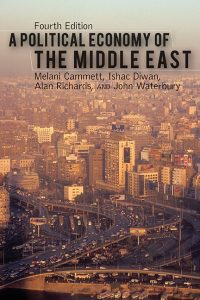|
Reviewed by: Natalie Ghosn, Esq., Attorney at Law, Ph.D. Student International Studies, University of Miami The fourth edition of A Political Economy of the Middle East serves as an updated volume of a modern take on political economy in the Middle East. The book tackles the explanation of modern political and economic phenomenon in the Middle East; such as, as the chapter titles indicate, the impacts of demographic change, the role of human capital, the dire concerns over water and food security, regime change, crony capitalism, the rise of the Gulf Cooperation Council (“GCC”), the effects of war, conflict and the military, the role of civil society and social movements, the role of Islam and the landscape of regional and global economic integration in the Middle East region with an understanding that the landscape in the region is rapidly transforming. As is made quite clear, the book is comprehensive in nature and focuses on in-depth economic and political explanations when analyzing the region as opposed to the traditional historical analyses that dominated research in this region in this field in the past. Cammett, Diwan, Richards and Waterbury (“the authors”) in the introduction explain, “[i]t is already clear that these societies have come of age and that they are unlikely to be dominated by autocrats in the future as they have been in the past” (p. 1). A number of explanations are offered to explain the so-called Arab Spring that has been unfolding in the Middle East since 2011. These explanations are given with the preface that they do not and cannot operate exclusively of each other; rather, that they work in tandem interacting and fueling one another.
2. The Resource-Rich, Labor Abundant RRLA Countries: those with high populations and high oil wealth; 3. The Resource Rich, Labor Poor RRLP Countries: those with sparse indigenous populations and high oil-deposits (preface xv). The authors further explore three variables that underlie their analysis of the region: state institutions, economic growth patterns, and social actors which are discussed sequentially in this book. The authors confirm that the differences between the economic and regional groupings of these nations helps to “explain some of the variation in the trajectories of the Arab uprisings” (p. 7). The most important among these factors appears to be oil wealth and its distribution among differing sized populations. For example, the so-called “oil-curse” tends to “afflict the labor-abundant countries far more than their sparsely populated wealthy counterparts” (p. 78). In terms of population the authors explain that the system of patronage from oil rents in the richest countries is unsustainable because of rapid population growth and that “in poor countries, fast population growth creates a poverty trap” which results in increased difficulty in attracting investment needed for development (p. 141). The authors further caution that oil wealth alone cannot explain all politics and; as such, the final phase of development includes a diversification away from oil dependency for a more stable economy. In addition, “virtuous circles” can be created with investments directed towards “education, fertility decline, and labor productivity” (p. 160). While the authors concur that development is largely an economic phenomenon, they make sure to emphasize the importance of politics and this concept is explored throughout the entirety of this volume. They declare, “any framework for understanding development trajectories – that is, the patterns of economic exchange and structural transformation manifested in society – must start with politics” (p.9). Besides the focus on politics, the authors also examine the effect of globalization, post-1980s, on the world economy. The importance of regime type is also explored along with a variety of other factors; such as, the role of geography. In this regard, the authors explain, “arid zones like the Middle East cannot escape geography: water is scarce in the region and will become scarcer” making domestic food production fall short as compared to the rapidly rising population growth in the region (p.201 and 208). In a discussion of Islamism, the authors conclude that Islamism works much like other theories of state-response and that it is, “like statism and neoliberalism” a “response to concrete, complex historical condition” (p. 473). Overall, among the discussions of a variety of important factors, the authors conclude that “regional labor migration has transformed the political economy of the region more – at least so far – than trade in goods or capital flows” (p. 500). With regard to the so-called Arab Spring, the authors conclude that there is a deeper reasoning behind why people would take great personal and familial risk in rising up and as such economic and political factors alone cannot explain the uprisings (p.392). This work was clearly written and logically ordered. It can serve as a textbook in any international political economy course focusing on the Middle East or any comparative political economy course as the authors continually make reference and comparison to other regions; such as, Europe or Latin America when applicable. At the very least, if a reader is ever planning to run their own nation, by the end of this book they will have a pretty good idea on how to do this in terms of what economic reforms they should pursue and what outcomes may result from different economic and political reform paths taken. |


 A Political Economy of the Middle East, Fourth Edition
A Political Economy of the Middle East, Fourth Edition